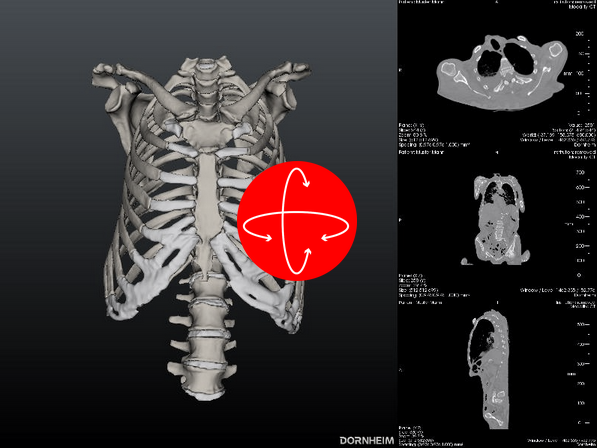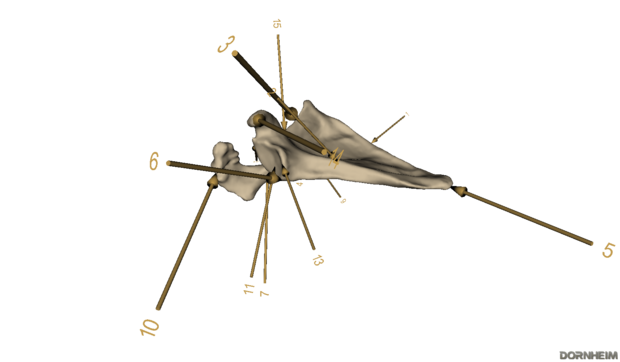Schulterblatt/en: Unterschied zwischen den Versionen
Becher (Diskussion | Beiträge) |
Becher (Diskussion | Beiträge) |
||
| Zeile 12: | Zeile 12: | ||
<!--[segmenter_snapshot schulter 7]-->[[File:Scapula.png|620px|right|Scapula with inscriptions]]<!--[/]--> | <!--[segmenter_snapshot schulter 7]-->[[File:Scapula.png|620px|right|Scapula with inscriptions]]<!--[/]--> | ||
| − | + | The <i>Angulus acromii</i> is an easily palpable bone point that marks the point where the lateral edge of the <i>Acromion</i> merges into the <i>Spina scapulae</i>. | |
| + | The <i> lateral angulus</i> is the location of the acetabulum, the <i>cavitas glenoidalis</i> (11). At its upper margin a small hump is visible, the <i>Tuberculum supraglenoidale</i> (12). Below the <i>Cavitas</i> is the <i>Tuberculum infraglenoidale</i> (13). After <i>cavitas glenoidalis</i> the neck of the scapula lies, <i>collum scapulae</i>.<br /> | ||
| + | Above the <i>Cavitas glenoidalis</i> rises the raven beak process, <i>Processus coracoideus</i> (14). It bends at right angles to lateroventral and ends flattened. Together with the <i>acromion</i> it protects the underlying joint. Medial from the base of <i>processus coracoideus</i> is found in <i>margo superior</i> an incision, <i>incisura scapulae</i> (15).<br /> | ||
| + | The bony socket <i>Cavitas glenoidalis</i> (11) of the <i>Articulatio humeri</i>, a ball joint, is considerably smaller than the head of the humerus. The socket is enlarged by a fibrous cartilaginous joint lip, <i>Labrum glenoidale</i>. The surface of the <i>Cavitas glenoidalis</i> is approx. 6qcm. The weight of the upper extremity is about 4 kg. Since there are no stronger ligaments, the muscles surrounding the joint must secure it. This is why we speak of a muscle-secured joint. The so-called "rotator cuff" is part of this muscular securing and especially strengthens the joint capsule. | ||
noch ein | noch ein | ||
Version vom 12. Dezember 2019, 12:33 Uhr
Structure of the shoulder blade (Scapula)
The shoulder blade, Scapula, is a flat three-sided bone whose margins, Margo medialis (1), Margo lateralis (2), and Margo superior (3), are separated by angles, Angulus superior (4), Angulus inferior (5) and the sloped Angulus lateralis (6).
The anterior surface, the Facies costalis, is flat and slightly hollowed (Fossa subscapularis). It sometimes shows well-formed line musculares. The facies posterior is divided by the shoulder bones, spina scapulae (7), into a smaller fossa supraspinata (8) and a larger fossa infraspinata (9). The spina scapulae begins with a triangular field (trigonum spinae) on the medial side, increases laterally in height and ends with a flattened extension, the shoulder height, acromion (10).
Close to the lateral end is an oval articular surface for connection to the clavicle, the Facies articularis clavicularis.
The Angulus acromii is an easily palpable bone point that marks the point where the lateral edge of the Acromion merges into the Spina scapulae.
The lateral angulus is the location of the acetabulum, the cavitas glenoidalis (11). At its upper margin a small hump is visible, the Tuberculum supraglenoidale (12). Below the Cavitas is the Tuberculum infraglenoidale (13). After cavitas glenoidalis the neck of the scapula lies, collum scapulae.
Above the Cavitas glenoidalis rises the raven beak process, Processus coracoideus (14). It bends at right angles to lateroventral and ends flattened. Together with the acromion it protects the underlying joint. Medial from the base of processus coracoideus is found in margo superior an incision, incisura scapulae (15).
The bony socket Cavitas glenoidalis (11) of the Articulatio humeri, a ball joint, is considerably smaller than the head of the humerus. The socket is enlarged by a fibrous cartilaginous joint lip, Labrum glenoidale. The surface of the Cavitas glenoidalis is approx. 6qcm. The weight of the upper extremity is about 4 kg. Since there are no stronger ligaments, the muscles surrounding the joint must secure it. This is why we speak of a muscle-secured joint. The so-called "rotator cuff" is part of this muscular securing and especially strengthens the joint capsule.
noch ein
test
ende
ende
ende
reciht

